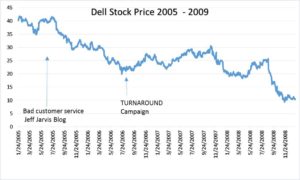A guide to ONLINE CRISIS MANAGEMENT
You got ready and put on your finest designer clothes going to enjoy your day and thinking all is great and suddenly a truck sped past and sprayed a splatter of mud in your brand new threads. Wow! How did a great beginning end like this? This is a nightmare not only individuals encounter but companies too in a form of online reputation management issue, damage control. Damage to your brand reputation! How can companies practice good brand monitoring and online brand crisis management?
The mud splatter is equivalent to online reputation disaster. Let us take Dell Computers as an example. Due to cost cutting measures they outsourced customer service externally in foreign countries. The level of service quality gradually deteriorated starting in 2002. An online brand crisis event happened in 2005 that caused the stock to plummet and lose 28% of its value in November 10, 2005. By June of 2006 it was down 40% from its July 2005 value. This is was more disastrous and catastrophic than a mud splatter. How should a company prepare for such an online reputation crisis and how to prevent a damage like this one from happening?

realty metrics
Brand Monitoring and Online Reputation management is an important part of a company’s arsenal for their online presence in this digital age. Building up a reputation is a long process involving time and trust to build credibility. One wrong click will destroy all these hard work. So how does one monitor and protect a brand from damaging reputation?
Proactive measures are more important than reactive measures. When Dell computers heard about the complaints from all their unsatisfied customers, they did nothing about it. The customer service level was in an all-time low. When Jeff Jarvis, a journalist tired of being ignored and shoved in the corner and with Dell hoping and praying these kinds of unsatisfied customers will just “poof” and disappeared. Jeff Jarvis had enough of this treatment and helplessness. He empowered himself and blogged about his experience with Dell Computers’ customer service woes and also journal it in detailed.
The result was catastrophic online brand reputation damage. Jeff Jarvis’ blog “DELL SUCKS. DELL LIES. Put that in your Google and smoke it Dell” was written, it attracted scores and scores of Dell’s unsatisfied customers around the world and incited a movement that banded all unsatisfied and mistreated customers and gave them a voice. This went viral in the social media pages and the volume and momentum was picked up my mainstream media. This led to a massive public relations explosion and damage to the Dell brand online and offline.
Funny thing was when this was going on, Dell did not respond immediately. Dell did not contact Jeff Jarvis immediately. Dell did not do anything immediately. The dominoes continue to fall there was no one to stop it. There was no one listening at Dell no damage control measures. Finally Dell responded on July 11, 2006 with a blog of their own titled “Direct Conversations with Dell.” This is a first attempt to turnaround the issue. This was only on content but there was nowhere in the blog for customer engagement and conversations. It was only filled with public relations materials on how good and wonderful Dell as a company.1 Dell’s PR Expert Rubel replied “Dell Starts Corporate Blog, But Fails to Address Critical Issues…Dell really failed to get the blog going the way that they could have. This was a golden opportunity for the company. They could use the blog to engage the community in a genuine conversation on the critical issues that have dogged them for years now as well as the good things they are doing… Instead, the Dell blog reads like a corporate brochure.” 2 This is a good start and Lionel Menchaca took over and started direct customer engagement. What was created was one2one weblog3. It encouraged feedback and Dell employees responded on these feedback.
The first test of this blog was at a Japanese conference a Dell laptop exploded. With the blog it was easier to communicate the recall and address customers concerns directly and ease their fears. The blog traffic helped ease the phone traffic help line that it saved Dell customer service costs. It was pointed out in the blog that the issue is related to Sony and not directly at Dell.

http://www.theinquirer.net/inquirer/news/1042700/dell-laptop-explodes-japanese-conference
Dell was a bit late but eventually did rescue the situation by focusing direct customer contact through one2one. They did contact Jeff Jarvis directly and gave Dell a “human voice” Jarvis said, “Manchaca gave customer respect and “got respect in return. It works.” .4 Learning from this experience, Dell took the initiative to expand how to engage directly with their customers and bloggers. Dell created Direct2Dell and Dell IdeaStorm. In 2013, due to shrinking PC market and competition Dell left Nasdaq after almost 25 years with a $24.4 billion stock buyback.
What are the important tips to Brand Monitoring and Online Reputation Management?
- Maintain a good reputation of the company with the management and staff standing by it.
- Continuously monitor company strategy and processes to be in line with company values
- Listen to the customers. Use online listening tools to monitor whispers, discontent and satisfaction. Join the conversation. Get involved. Control the damage.
- Respond immediately no matter how big or small the issue is. Respond according to the media of the commenters choice
- When there is an issue. Fix the customer first then the issue
- Do not hide criticism, answer to valid criticism. Do not avoid difficult issue.
- Behave in a transparent manner. Show the customer’s their comments are being listened to, give feedback and praise good ideas
- Have a turnaround campaign. Show how to improve, correct and take ownership of mistakes
- Work on rebuilding trust and credibility. Listen. Listen. Listen
- Innovate and improve from the mistake.
To develop a strong online image, a company must not ignore the online netizens. It is important to have easy access to contact information for the engaging public. It is a must to address negative reviews with timeliness and transparency to instill trust. The website, twitter and other social media accounts must be engaging and easy to use and beneficial to the user.
Brand Monitoring and Online Reputation Management is important for any business large or small. It is important to be proactive in damage control and have an ear to the social media channels. There are a lot of tools to assist in listening to the sentiment, volume of engagements and frequency. The tools can also help monitor competitors and what is trending. Overall being oblivious of the power of social media is not an excuse for mismanaging your company brand.
Jennifer Chan is a licensed real estate representative and digital marketer in Ontario, Canada.
Citations:
- http://www.buzzmachine.com/2006/07/10/well-well-dell-2/
- http://www.micropersuasion.com/2006/07/dell_starts_cor.html
- http://direct2dell.com/one2one/archive/2006/07/11/117.aspx
- http://customerthink.com/you_can_learn_dell_hell_dell_did/